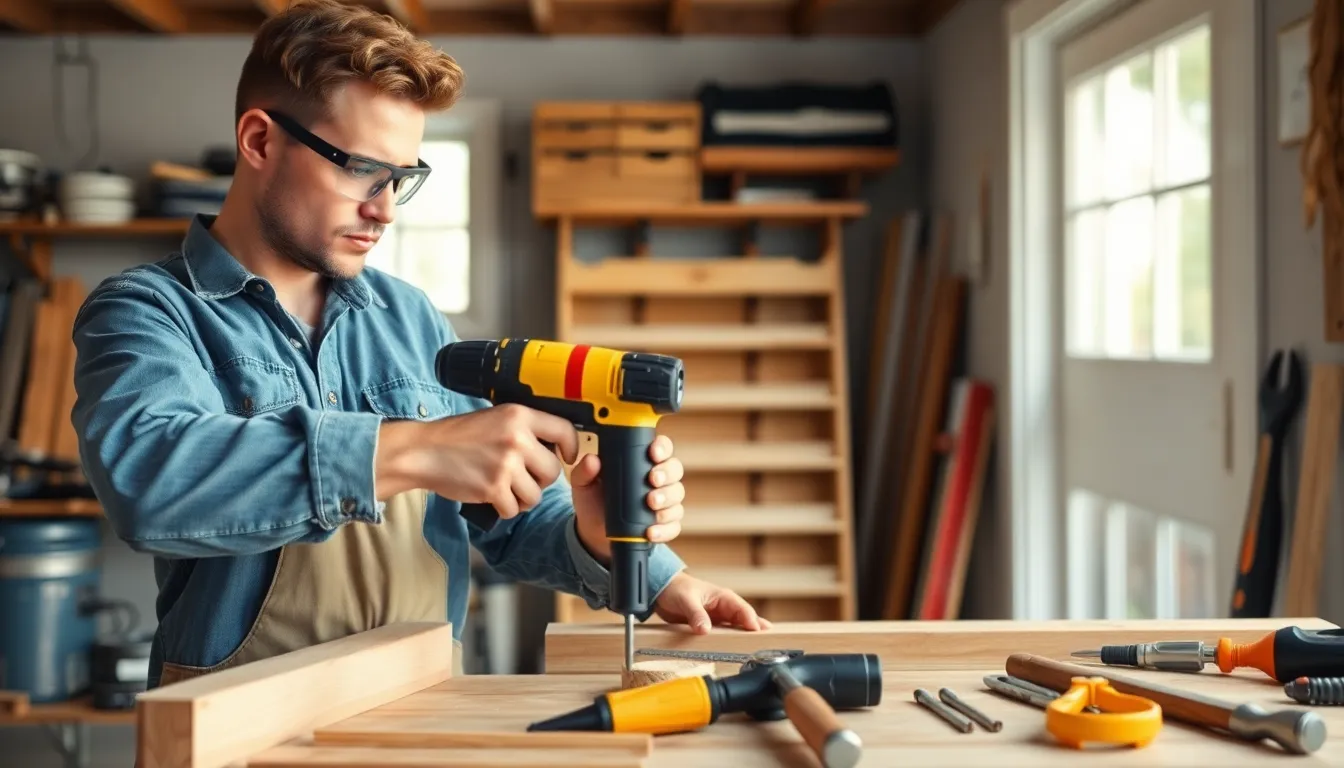Ever looked around your home and thought, “I could totally make that better”? Well, it’s time to swap that daydream for a paintbrush and some power tools. DIY home projects for beginners are not just a way to spruce up your space; they’re a ticket to unleash your inner handyman or handywoman. Plus, who doesn’t want to impress friends with a handcrafted coffee table or a quirky garden planter?
DIY Home Projects for Beginners
DIY home projects offer a fantastic opportunity for beginners to improve living spaces while enjoying hands-on creativity. Exploring easy tasks can help individuals gain confidence in their abilities. Many projects require minimal tools and materials, making them accessible and affordable.
Furniture refurbishing stands out as a popular choice. This process involves updating old pieces with paint or new hardware to create unique additions to any room. Garden enhancements like raised beds or decorative planters also provide an inviting outdoor space.
Simple decor items often require little skill, yet they can dramatically transform a room. Handmade shelves or wall art personalize living environments and reflect personal style. Organization projects, such as building storage boxes or pegboards, make spaces functional and clutter-free.
One common starting project involves painting a room. Choosing a fresh color adds an instant update while allowing for self-expression. Light fixture replacements also offer a chance to refresh a space by selecting stylish options that suit personal taste.
Assembling kits are another easy way to begin DIY ventures. These often include clear instructions and all necessary components, ensuring a rewarding experience. Engaging in community workshops can further boost confidence and offer valuable learning opportunities alongside experienced DIYers.
Taking the leap into DIY home projects provides beginners with the chance to improve their skills while creating something special. By selecting appropriate projects, they can enjoy the fulfillment of completing tasks and showcasing their creativity.
Essential Tools for DIY Projects

Having the right tools makes DIY projects more manageable and enjoyable. Beginners should invest in a few essential hand tools and power tools to get started.
Basic Hand Tools
Basic hand tools are crucial for any DIYer. A hammer is necessary for driving nails and removing them. Screwdrivers, both flat-head and Phillips, are essential for assembling furniture or tightening fixtures. Pliers assist with gripping and twisting. A measuring tape allows for precise cuts and measurements. Lastly, a utility knife is handy for cutting various materials. These tools form the foundation for a successful DIY toolkit.
Power Tools for Beginners
Power tools can greatly simplify DIY tasks. A cordless drill is versatile for drilling holes and driving screws. A jigsaw enables cutting curves and intricate shapes in wood or plastic. Circular saws help make straight cuts quickly. Sanding tools, like a palm sander, create smooth finishes on wood surfaces. Beginners benefit from these tools, enhancing efficiency while learning.
Popular DIY Home Projects
These projects appeal to beginners seeking to enhance their homes while developing new skills. The options range from simple upgrades to outdoor enhancements.
Simple Furniture Upgrades
Refurbishing existing furniture offers an excellent entry point for beginners. A fresh coat of paint or new hardware can transform a basic piece into a unique statement. Sanding down old furniture adds a rustic charm, while reupholstering chairs revitalizes tired cushions. Handcrafted items, like shelf organizers or customized coffee tables, showcase creativity and personalize living spaces. Choosing projects based on available materials ensures both affordability and creativity.
Garden and Outdoor Projects
Enhancing outdoor spaces invites creativity and relaxation. Planting a vegetable garden introduces beginners to gardening fundamentals and rewards with fresh produce. Building raised garden beds maximizes space and improves drainage. Paver pathways lead guests through charming landscapes and provide structure. Additionally, creating birdhouses adds whimsy while supporting local wildlife. Designing simple outdoor furniture or planters encourages outdoor enjoyment and beautifies patios or decks.
Safety Tips for DIY Success
Safety is paramount when engaging in DIY projects. Always wear appropriate personal protective equipment such as safety goggles, gloves, and masks. These items guard against injuries from dust, debris, and sharp tools during projects.
Assess the workspace before starting. An organized space reduces the risk of accidents and helps maintain focus. Keep tools stored properly and avoid clutter to create a safer environment.
Consider reading project instructions thoroughly. Understanding the steps and necessary precautions minimizes errors and enhances safety. If unclear, seek out tutorials or community workshops for additional guidance.
Monitor surroundings while working. Ensure pets and children stay at a safe distance to prevent unexpected interruptions. Designate a clear area for your project to keep distractions at bay and maintain concentration.
Stay aware of tool operation. Follow manufacturer guidelines when using equipment. For power tools, always check for defects before use and make sure safety features function properly.
Check for electrical hazards. If a project involves electrical work, turn off power at the source to prevent shocks. Use voltage testers to ensure wires are not live before starting any electrical tasks.
Stay hydrated and take breaks. Fatigue increases the likelihood of accidents. Taking regular breaks helps maintain energy levels and focus throughout the project.
Address any spills or hazards immediately. Clean up as you go, especially with paint or chemicals, to prevent slips and falls. Keeping the workspace tidy promotes a safer working environment.
Following these safety tips ensures a successful and enjoyable DIY experience while fostering confidence in home improvement tasks.
Resources for Learning and Inspiration
Online tutorials provide valuable insights for those new to DIY projects. Websites like YouTube host countless videos that demonstrate techniques ranging from painting to furniture assembly. Blogs dedicated to home improvement offer step-by-step guides for various projects. These blogs often include personal experiences, tips, and challenges encountered during the process.
Community workshops serve as excellent venues for hands-on learning. Local hardware stores or community centers frequently organize events that teach useful skills and foster a sense of community. Participants can gain confidence while learning from experienced instructors who guide them through different DIY tasks.
Books on home improvement also serve as significant resources. Several titles cater specifically to beginners, featuring illustrations and easy-to-follow instructions. Browsing sections in local libraries or bookstores can unveil numerous options tailored to various skill levels.
Social media platforms showcase DIY projects that inspire creativity. Users frequently share their successes and techniques on Instagram and Pinterest, providing fresh ideas. Additionally, engaging with communities on these platforms can spark conversations and motivate individuals to try new projects.
Podcasts dedicated to home improvement offer a unique listening experience for those on the go. Many podcasts discuss tips, tricks, and project ideas, making it easy to learn while commuting or during downtime. These auditory resources extend the reach of DIY knowledge beyond traditional methods.
Utilizing these diverse resources equips beginners with the skills and inspiration needed to tackle home projects. Engaging with various mediums ensures a comprehensive understanding of DIY practices while enhancing creativity. Exploring these options lays a strong foundation for successful project outcomes.
Conclusion
Embarking on DIY home projects opens up a world of creativity and personal expression. These beginner-friendly tasks not only beautify living spaces but also foster a sense of accomplishment. With the right tools and safety measures in place, anyone can tackle these projects confidently.
Exploring various resources for guidance ensures that beginners can learn and grow throughout their DIY journey. Whether it’s refurbishing furniture or enhancing outdoor spaces, each project offers a unique opportunity to develop skills and create something special. Embracing DIY not only transforms homes but also nurtures a fulfilling hobby that can last a lifetime.

